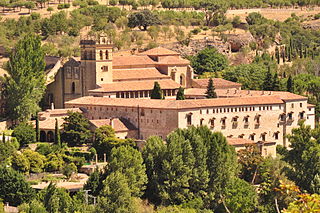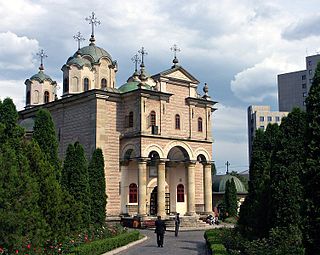| Bârnova Monastery | |
|---|---|
 | |
| Basic information | |
| Location | Bârnova, Romania |
| Affiliation | Romanian Orthodox Church |
| Architectural description | |
| Architectural style | Moldavian, Byzantine |
| Completed | 1628 |
| Materials | stone, brick |
The Bârnova Monastery (Romanian : Mănăstirea Bârnova) is a Romanian Orthodox monastery located in Bârnova, Iași metropolitan area, Moldavia, Romania.

Romanian is an Eastern Romance language spoken by approximately 24–26 million people as a native language, primarily in Romania and Moldova, and by another 4 million people as a second language. It is an official and national language of Romania and Moldova. In addition, it is also one of the official languages of the European Union.

The Romanian Orthodox Church is an autocephalous Orthodox Church in full communion with other Eastern Orthodox Christian Churches, one of the nine Patriarchates in the Eastern Orthodox Church. Since 1925, the Church's Primate bears the title of Patriarch. Its jurisdiction covers the territories of Romania and Moldova, with additional dioceses for Romanians living in nearby Serbia and Hungary, as well as for diaspora communities in Central and Western Europe, North America and Oceania.

A monastery is a building or complex of buildings comprising the domestic quarters and workplaces of monastics, monks or nuns, whether living in communities or alone (hermits). A monastery generally includes a place reserved for prayer which may be a chapel, church, or temple, and may also serve as an oratory.
Built in 1628 by Moldavian Voivode Miron Barnovschi-Movilă, [1] the monastery is listed in the National Register of Historic Monuments. [2]

Moldavia is a historical region and former principality in Central and Eastern Europe, corresponding to the territory between the Eastern Carpathians and the Dniester River. An initially independent and later autonomous state, it existed from the 14th century to 1859, when it united with Wallachia as the basis of the modern Romanian state; at various times, Moldavia included the regions of Bessarabia, all of Bukovina and Hertza. The region of Pokuttya was also part of it for a period of time.

The National Register of Historic Monuments is the official English name of the Romania government's list of National Heritage Sites known as Monumente istorice. In Romania, these include sites, buildings, structures, and objects considered worthy of preservation due to the importance of their Romanian cultural heritage. The list, created in 2004, contains places that have been designated by the Ministry of Culture and National Patrimony of Romania and are maintained by the Romanian National Institute of Historical Monuments, as being of national historic significance.
The oldest tree in Iași County is the 675-year-old hybrid lime tree (declared Natural Monument), located in the courtyard of Bârnova Monastery. When the lime was about 57 years old and had about 14 centimetres in diameter, Iași was mentioned as an urban settlement, during the reign of Prince Alexander the Good (1408). [3]

Iași County is a county (județ) of Romania, in Moldavia, with the administrative seat at Iași. It is the most populous county in Romania, after the Municipality of Bucharest.

Alexander the Good was a Voivode (Prince) of Moldavia, reigning between 1400 and 1432, son of Roman I Mușat. He succeeded Iuga to the throne, and, as a ruler, initiated a series of reforms while consolidating the status of the Moldavian Principality.

















